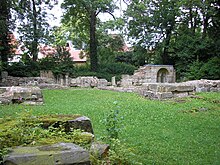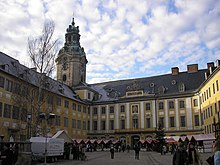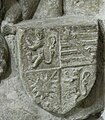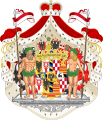Schwarzburg (noble family)
The Schwarzburger belonged to the old Thuringian aristocracy . The headquarters " Swartzinburg " is located in the valley on the Schwarza west of Saalfeld in the Thuringian district of Saalfeld-Rudolstadt and was first mentioned in 1071. In 1599 the two counties and later principalities of Schwarzburg-Rudolstadt and Schwarzburg-Sondershausen emerged . In 1918, Günther Victor von Schwarzburg-Rudolstadt resigned the affairs of state for the two principalities last ruled in personal union as a result of the November Revolution and declared his resignation. The Schwarzburger sex became extinct in the male line in 1971.
prehistory

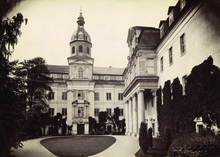
→ for the prehistory see sizzonen
The secured story begins in the middle of the 12th century. Earlier scholars tried to deduce a Frankish origin of the Schwarzburger. A gundar who lived in the 8th century was an ancestor of the family and the son of a Frankish king. Pope Gregory II mentioned Gundhareus (Gundar) in a letter in 722. In the Käfernburg painting this gundar is shown next to Sigerius and Sizzo. Gundar is said to have been the builder of the Käfernburg near Arnstadt . According to the Reinhardsbrunn Chronicle, Sigerius was his son and Sizzo lived around 1000. The family is said to have descended from the Sizzonen who appeared in Thuringia at the beginning of the 11th century.
The common descent of the Schwarzburger and Kevernburger is undisputed among historians . The family owned Ilmenau , Remda and Plaue as an allodial property . The Reichslehen Schwarzburg, Ehrenstein and Königsee were also under the rule of the Schwarzburgers . Fiefs were from Bohemia Rudolstadt, from Kurmainz Sondershausen, from Kursachsen Frankenhausen, from Saxe-Weimar Arnstadt and from Saxe-Gotha Ilm and Paulinzella . There were also further fiefdoms from Fulda and Hessen-Kassel.
Sizzo III. (* around 1080, † 1160) was the first reliably detectable family member. He was named Count of Kevernburg in documents (1141, 1143 and 1144). Also Sizzo III was. referred to as Graf in Thuringia, Graf im Längwitzgau and Graf von Schwarzburg. The Count donated to 1142, the south of Gotha preferred Monastery Georgenthal and was Vogt of Paulinzella . In the literature, Gunther the hermit (* around 955; † 1045) is often cited as his ancestor . The relationship cannot be proven, although Gunther is on the grave slab of King Günther XXI. von Schwarzburg-Blankenburg (* 1304; † 1349) is shown. In the time after Sizzo III. The separate counties of Kevernburg and Schwarzburg were formed. The Schwarzburger were able to enlarge their property, the Kevernburger became meaningless.
The Counts of Schwarzburg
Sizzo III. von Kevernburg was first mentioned in 1103 and called himself Graf von Schwarzburg from 1123 onwards. He was the common progenitor of the House of Kevernburg-Schwarzburg. After the first mention of the Schwarzburg headquarters in 1071, it took over a hundred years for the family members to permanently bear the name Schwarzburg. In the middle of the 12th century, the Blackburgs owned the Käfernburg with the area around Arnstadt , the Schwarzburg with the Thuringian Forest and the Rabenswalde Castle near Wiehe with the area of the lower Unstrut and the Finns .
Heinrich I , the eldest son of Sizzos III, owned the Schwarzburg with the associated villages and half of the city of Ilm . His brother Günther II owned the Käfernburg and after the death of Heinrich I inherited the Grafschaft Schwarzburg. The Schwarzburgers saw the beginning of their independence only in the generation after Günther II. His son Heinrich II was the heir of the Schwarzburg and is considered the progenitor of the Counts and Princes of Schwarzburg. He supported the future King Philip of Swabia from the Staufer family in his efforts to gain supremacy in the Holy Roman Empire . From 1228 he also stood at the side of the Staufer Emperor Friedrich II during his crusade to Palestine . Heinrich II was enfeoffed with Saalfeld and Ranis in thanks for his services , who remained in the family's property until 1389. The count had three sons, Heinrich III. († 1259), Günther VII. († 1274) and Albrecht II. († 1278). Henry III. After the death of his father got the Schwarzburg and Kranichfeld , Günther VII got Blankenburg and Albrecht II got a financial compensation.
Günther II was the founder of the House of Kevernburg. In 1191 the County of Hallermund fell to the Count, which enabled the Käfernburg branch of Hallermund to emerge with his son Ludolf II . With the death of Otto III. von Hallermund, the line went out in 1412. The Kevernburg line only existed until 1385. After an interim phase with the Landgraves of Thuringia , the Käfernburg came to the Schwarzburg relatives in 1446. The Käfernburg remained with the Schwarzburgers, but the building fell into disrepair after the Thirty Years War . Albert I († 1236), a son of Günther III., Founded the Käfernburg branch line Rabenswalde . Albert I's possessions consisted of the Rabenswalde Castle , the castle and the town of Wiehe and various areas. He ruled from Rabenswalde Castle and called himself Graf von Rabenswalde and Graf von Wiehe. The count was named in a document in 1249 in which he and other nobles submitted to the rule of Margrave Heinrich von Meißen. The Rabenswalde line only existed for a short time and expired with Friedrich in 1312.
The historically significant Schwarzburg-Blankenburg line began with Günther VII († 1274). After his brother Heinrich III. von Schwarzburg died in 1259 without an heir, the Schwarzburg-Blankenburg line coincided with the Schwarzburg line again. Heinrich V († 1285), the son of Günther VII, then re-established the Schwarzburg-Blankenburg line. Günther IX. († 1289), the brother of Heinrich V, founded the Schwarzburg-Schwarzburg line in 1274, which existed until 1397. The branch lines Schwarzburg-Wachsenburg (1327) and Schwarzburg-Leutenberg (1362), split off from the Schwarzburg-Schwarzburg line , continued to exist. Günther X. (XVIII.) († 1354) was the founder of the Schwarzburg-Wachsenburg line and resided at the Wachsenburg Fortress near Arnstadt . He received together with his brother Heinrich IX. around 1310 the Leuchtenburg as pledge and 1333 as property. In addition to Wachsenburg, the counts had various residences, including Kranichfeld . For financial reasons, the family was forced to sell the Wachsenburg to the Thuringian landgraves in 1369. The Wachsenburg sideline was discontinued in 1450. Henry XI. (XV.) († 1402) donated the Schwarzburg-Leutenberg line. The castle and the town of Leutenberg were acquired through purchase, and Leutenberg became a permanent residence. In 1564, the Leutenberg line went out and ownership went to the Schwarzburg-Rudolstadt line that then existed.
At the beginning of the 14th century, the Schwarzburger built possessions in the Gera river basin to the north and along the Saale to the northeast. Ownership could also be obtained in northern Thuringia. The family acquired Schlotheim in this area in 1338 and Frankenhausen in 1340 , supplemented by an inheritance. At the end of the 14th century, almost the territories that later corresponded to the Schwarzburg subordinates of Sondershausen and Frankenhausen arose in northern Thuringia. The areas of the lower Unstrut and the middle Saale, however, were soon lost again. Rudolstadt finally came into the possession of the Schwarzburger in 1334.
The Counts of Schwarzburg also had ambitions in the Holy Roman Empire . They had an extremely good relationship with the Wittelsbachers . Günther XXI. von Schwarzburg-Blankenburg , a grandson of Heinrich V, worked from 1330 as commander and diplomat for Emperor Ludwig IV of Bavaria . After a division of the estate, he only owned Blankenburg and a quarter of Saalfeld. Arnstadt and Schlotheim and Frankenhausen in northern Thuringia were added later. After Ludwig's death in October 1347, Günther XXI. January 30, 1349 Frankfurt as a representative of the Bavarian party for anti-king to Charles IV. from the house Luxembourg choose. The coronation took place in Frankfurt on February 6 of the same year. Günther XXI. could not enforce his claim and renounced on May 26, 1349 in the Treaty of Eltville on the royal rights. He received financial compensation and an amnesty for his followers. A short time later he fell seriously ill and died on June 14, 1349 in the Johanniterkloster in Frankfurt, presumably of the plague . The count found his resting place as the only German king in the Imperial Cathedral of St. Bartholomew in Frankfurt.
The Schwarzburger were also actors in the Thuringian Count War between 1342 and 1346. As a result of the Thuringian Count Feud, Thuringia was territorially reclassified and then remained essentially unchanged until 1918. In the individual principalities, however, the changes due to the division of states were significant. After the war, the hegemonic power was the Wettins , whose main opponents were the Counts of Orlamünde and the Counts of Schwarzburg. In 1389 the Schwarzburgers were forced to sell Saalfeld to the Wettins. The rule Ranis with Kamsdorf and Goßwitz also went to the Wettiner. Although a limit was set for the Schwarzburger striving for power, like the Russians , they remained historically present.
Under the rule of Günther XL. von Schwarzburg (* 1499; † 1552) from the Schwarzburg-Blankenburg line, the Schwarzburg possessions were almost united. The Reformation brought social changes. He left behind the four sons Albrecht , Johann Günther , Günther and Wilhelm . The last two counts named died childless. The lines of the regents Albrecht VII and Johann Günther I were historically relevant. The lines Schwarzburg-Rudolstadt and Schwarzburg-Sondershausen were created, which were initially referred to as the Arnstadt line. A division into two newly cut territories was specified in the Stadtilm Treaty of November 21, 1599. The areas of the two counties and later principalities of Schwarzburg-Rudolstadt and Schwarzburg-Sondershausen did not change for over 300 years until 1918. The territories were part of the Upper Saxon Empire in the Holy Roman Empire .
The Schwarzburg principalities

Principalities developed from the two independent counties of Schwarzburg-Rudolstadt and Schwarzburg-Sondershausen. In 1697, Emperor Leopold I declared that he was elevated to the rank of imperial prince . Christian Wilhelm accepted the increase in status for Schwarzburg-Sondershausen. On the other hand, Albert Anton refused this for Schwarzburg-Rudolstadt for various reasons. For the Rudolstadt line it was pronounced and accepted again by Emperor Joseph I in 1710 . The introduction of primogeniture prevented future Zerteilungen possession. In Schwarzburg-Rudolstadt, the priority of the firstborn was determined in 1710 and confirmed by the Emperor in 1716. At Schwarzburg-Sondershausen the primogeniture was valid from 1716 and was confirmed in 1719. He was accepted into the Imperial Council of Princes in 1754.
The Principality of Schwarzburg-Rudolstadt had around 100,000 inhabitants in 1910, the Principality of Schwarzburg-Sondershausen around 90,000 inhabitants. The last ruling Prince of Schwarzburg, Günther Victor von Schwarzburg-Rudolstadt , laid down on 23/25. November 1918 as the last German prince to put down government affairs. After the end of the monarchy , the Free States of Schwarzburg-Rudolstadt and Schwarzburg-Sondershausen emerged in 1918 . The state of Thuringia , which contained the areas of the two Schwarzburg principalities, was formed in 1920. The more important main line Schwarzburg-Rudolstadt went out in 1925 in a direct line with the death of the childless prince who, in addition to Schwarzburg-Rudolstadt, had also led the principality of Schwarzburg-Sondershausen in personal union, since the second main line had already expired in 1909 with Prince Karl Günther von Schwarzburg-Sondershausen . In 1925, Prince Sizzo von Leutenberg became head of the Schwarzburg family, and from 1910 he called himself Prince zu Schwarzburg. His son Prince Friedrich Günther died childless in 1971. Friedrich Günther's sister Marie Antoinette has descendants called Count and Countess zu Solms-Wildenfels .
Economically around 1900 in the principality of Schwarzburg-Rudolstadt in the supremacy of the forestry and in the subordinate rule the agriculture was pursued. Slate quarries existed in the Schwarza, Lichte and Loquitz valleys, and there was a salt works in Frankenhausen . The most important industries were the porcelain and glass industries in the supremacy. In the principality of Schwarzburg-Sondershausen there was agriculture and forestry, mining, metallurgy and various industries.
Dominions and residences
The areas of the Schwarzburger were classified as suzerainty or subordinate rule. The Schwarzburger Oberherrschaft encompassed an area in what is now the districts of Saalfeld-Rudolstadt (city of Rudolstadt ) and Ilm-Kreis (city of Arnstadt ) in southern Central Thuringia, the Schwarzburger Unterherrschaft was in today's Kyffhäuserkreis (cities of Sondershausen and Frankenhausen ) in northern Thuringia.
From 1599 onwards, Schwarzburg-Rudolstadt consisted of the greater part of the supremacy and the smaller part of the subordinate rule . The greater part of the subordinate and the smaller part of the supremacy belonged to Schwarzburg-Sondershausen . The residence was for Schwarzburg-Rudolstadt with the Heidecksburg in Rudolstadt and for Schwarzburg-Sondershausen in Sondershausen with Sondershausen Castle .
The supremacy of Schwarzburg-Rudolstadt consisted of the district court districts of Rudolstadt, Stadtilm, Königsee, Oberweißbach, the separate judicial district Leutenberg and four smaller parcels. The subordinate rule of Schwarzburg-Rudolstadt comprised the district court districts of Schlotheim and Frankenhausen. The offices of Kelbra and Heringen in Northern Thuringia were jointly owned between 1419 and 1815 by the Counts of Schwarzburg (from 1599 Schwarzburg-Rudolstadt ) and Counts of Stolberg (from 1706 Stolberg-Roßla ) under the suzerainty of the Albertine Wettins (later Electorate of Saxony ).
The parts of the Principality of Schwarzburg-Rudolstadt bordered on the neighboring states.
- Rudolstadt was surrounded by Saxe-Weimar-Eisenach , Saxe-Gotha-Altenburg , Saxe-Coburg-Saalfeld , Saxe-Meiningen , Saxe-Hildburghausen and Schwarzburg-Sondershausen.
- Leutenberg bordered on Reuss-Lobenstein , Reuss-Ebersdorf , Sachsen-Coburg-Saalfeld and the Prussian district of Ziegenrück .
- Schwarzburg-Sondershausen and the Prussian province of Saxony were near Frankenhausen .
- There were also seven own enclaves and foreign enclaves from other national areas.
The Principality of Schwarzburg-Sondershausen had the following neighboring states:
- Sondershausen had the Prussian province of Saxony and Schwarzburg-Rudolstadt as neighbors, the exclave of Volkenroda of Saxe-Gotha-Altenburg to the west of Sondershausen and the exclave of Straussberg of Schwarzburg-Rudolstadt.
- Arnstadt bordered Saxony-Gotha-Altenburg , the Prussian province of Saxony, and Schwarzburg-Rudolstadt.
- Gehren was near Schwarzburg-Rudolstadt, Sachsen-Hildburghausen and the Ilmenau exclave of Sachsen-Weimar-Eisenach .
Earlier, the Schwarzburg counts resided in the Längwitzgau in southeast Thuringia north of the Thuringian Forest between the rivers Gera and Schwarza, on the castles Schwarzburg , Burg Greifenstein (Bad Blankenburg) (from the 13th century), Wachsenburg (1306–1369), Leuchtenburg (1313– 1396), Schloss Friedensburg (Leutenberg) (from 1362) and the Käfernburg (from 1446), which from 1560 was replaced as the manorial seat of Schloss Neideck in Arnstadt until the residence was moved from there to Sondershausen in 1716. Further seats of the family were in the Kyffhäuserkreis in the north of Thuringia the castles Straussberg (from 1356) and Frankenhausen as well as the castle Ebeleben .
Greifenstein Castle (Bad Blankenburg) , seat of the Counts of Schwarzburg-Käfernburg from the 13th to 15th centuries
Käfernburg (model)
Neideck Castle in Arnstadt around 1580 (model)
Ebeleben Castle , 1855 (destroyed 1945)
The regents of Schwarzburg-Rudolstadt
Schwarzburg-Rudolstadt was ruled by the following counts and princes:
- 1574–1605 Albrecht VII , Count von Schwarzburg-Rudolstadt, son of Günther XL.
- 1605–1630 Karl Günther
- parallel 1612–1634 Albrecht Günther
- parallel 1612–1646 Ludwig Günther I.
- 1646–1662 guardian of Emilie von Delmenhorst
- 1662–1710 Albert Anton
- 1710–1718 Ludwig Friedrich I , 1710 elevated to the rank of imperial prince
- 1718–1744 Friedrich Anton
- 1744–1767 Johann Friedrich
- 1767–1790 Ludwig Günther II.
- 1790–1793 Friedrich Karl
- 1793–1807 Ludwig Friedrich II.
- 1807–1814 guardian of Karoline von Hessen-Homburg
- 1814–1867 Friedrich Günther
- 1867-1869 Albert
- 1869–1890 Georg Albert
- 1890–1918 Günther Victor ( personal union )
The regents of Schwarzburg-Sondershausen
The rulers of Schwarzburg-Sondershausen were:
- 1571–1586 Johann Günther I , Count of Schwarzburg-Sondershausen, son of Günther XL.
- 1586–1593 guardian of Anton I of Oldenburg and Johann VII of Oldenburg
- 1593–1594 Günther XLII.
- 1594-1600 Günther XLII. and Anton Heinrich
- 1600–1601 Günther XLII. , Anton Heinrich and Johann Günther II.
- 1601–1631 Günther XLII. , Anton Heinrich , Johann Günther II. And Christian Günther I.
- 1631–1638 Günther XLII. , Anton Heinrich and Christian Günther I.
- 1638–1642 Günther XLII. and Christian Günther I.
- 1642–1666 Christian Günther II. , Regent of the sovereignty ( Arnstadt )
- 1642–1666 Anton Günther I , regent of the subordination ( Sondershausen )
- 1642–1681 Ludwig Günther II. , Regent of the subordination ( Ebeleben )
- 1666–1716 Christian Wilhelm and Anton Günther II. , 1697 elevated to the rank of imperial prince
- 1716–1720 Christian Wilhelm , in 1697 raised to the rank of imperial prince
- 1720–1740 Günther I.
- 1740–1758 Heinrich
- 1758–1794 Christian Günther III.
- 1794–1835 Günther Friedrich Carl I.
- 1835–1880 Günther Friedrich Carl II.
- 1880–1909 Karl Günther
- 1909–1918 Günther Victor von Schwarzburg-Rudolstadt (personal union)
The buildings of the Schwarzburger
The Schwarzburg family palace

The Schwarzburg , the family seat, is in Schwarzburg . The "Swartzinburg" was mentioned in a document from Bishop Anno II of Cologne in 1071. With the expiry of the Schwarzburg-Schwarzburg line of the Count's House in 1450, the Schwarzburg came to the two still existing lines Schwarzburg-Arnstadt-Sondershausen and Schwarzburg-Leutenberg. Since then it has only been an adjacent seat, and the castle was used regularly by both lines on an equal footing until the 16th century. In 1584 the Schwarzburg fell completely to the House of Schwarzburg-Rudolstadt under Count Albrecht VII , who, however, continued to reside on the Heidecksburg . In 1664, the building complex was expanded like a fortress in order to be able to counter an attack by Ottoman troops. With the elevation of the Counts of Schwarzburg-Rudolstadt to the rank of imperial prince in 1710 under Ludwig Friedrich I , the previously neglected Schwarzburg Castle was upgraded as the ancestral seat of the Princely House and transformed into a representative manorial annex in the baroque style, with an "imperial hall" in honor of the Head of the Reich. Historically altered in the 19th century , the castle fell to the State of Thuringia in 1918, but the former princely family received right to live on the Schwarzburg. Schwarzburg Castle is currently being extensively restored.
The Heidecksburg in Rudolstadt

The residential palace Heidecksburg in the old town of Rudolstadt was built as a baroque building until the second half of the 18th century . Before that there was a three-wing renaissance castle , which burned down in 1735. The original castle of the Counts of Orlamünde dates from the 13th century. The castle was bought by the Schwarzburgers in 1334, but was destroyed in the Thuringian Count Feud in 1345. Construction work on today's castle began in 1737, with the building being similar in size to the previous Renaissance castle. The castle met the representational needs of the Schwarzburg-Rudolstadt line after it was elevated to the rank of imperial prince in 1710. Johann Christoph Knöffel was hired as the architect . The Heidecksburg was the residence of the counts and princes of Schwarzburg-Rudolstadt from 1574 to 1918. Today the premises are used by the Thuringian State Museum Heidecksburg and the Thuringian State Archives in Rudolstadt.
Sondershausen Castle

Sondershausen Castle in Sondershausen was the residence of the Schwarzburg-Sondershausen line. The earlier castle was first mentioned in 1287. In 1356 it became the property of the Counts of Schwarzburg. Count Günther XL. ("The rich man" or "the one with the fat mouth") had most of the castle demolished in 1533 and began building the renaissance castle in 1534 .
1837–1838 Prince Günther Friedrich Carl II had the palace complex redesigned in the classicist style by Schinkel's student Carl Scheppig . The widowed Princess Anna Luise von Schwarzburg lived in the castle until her death in 1951. It now houses a museum.
More locks
Frankenhausen Palace , Rudolstadt's secondary residence from 1339 to 1918
Ludwigsburg Palace (Rudolstadt) , built 1734–41
New palace in Arnstadt , Sondershauser widow's seat, around 1730
Ebeleben Castle , a castle lent to the Schwarzburgers since the 12th century, bought back in 1616 by the Schwarzburg-Sondershausen family
Hunting lodge Zum Possen (Sondershausen)
Hunting lodge at the Paulinzella monastery
Coat of arms and medals
The blazon of the coat of arms of the Counts of Kevernburg- Schwarzburg reads: "On blue a golden, also red-crowned, leopardized lion". After the elevation to the imperial prince status in 1697 and 1710, a new, increased coat of arms was adopted.
Coat of arms on the epitaph of the Würzburg Prince-Bishop Gerhard von Schwarzburg
Coat of arms of Schwarzburg-Rudolstadt
Coat of arms of Schwarzburg-Sondershausen
Cross of Honor of Schwarzburg
The common house order of the principalities of Schwarzburg-Rudolstadt and Schwarzburg-Sondershausen was the Schwarzburg Cross of Honor . It was donated on May 20, 1853 by Prince Friedrich Günther von Schwarzburg-Rudolstadt . From June 28, 1857, the award took place as a joint medal with the Princely House of Schwarzburg-Sondershausen.
Early family members
| Surname | Life dates | Remarks |
|---|---|---|
| Sizzo III. | * around 1080, † 1160 | Progenitor of Kevernburg-Schwarzburg |
| Heinrich I. | * around 1130, † 1184 | Son of Sizzo III. |
| Günther II. | * around 1135, † 1197 | Son of Sizzo III, founder of the Kevernburg line |
| Günther III. | † 1223 | Son of Günther II, whose son Albert I was the founder of the Kaefenburg line in Rabenswalde |
| Ludolf II. | † 1255 | Son of Günther II., Founder of the beetle burger line Hallermund |
| Henry II | * around 1150, † 1236 | Son of Günther II, ancestor of the Schwarzburger |
| Henry III. | † 1259 | Son of Heinrich II. |
| Günther VII. | † 1274 | Son of Heinrich II., Schwarzburg-Blankenburg line |
| Günther IX. | † 1289 | Son of Günther VII, founder of the Schwarzburg-Schwarzburg line |
| Henry V. | † 1285 | Son of Günther VII, now Schwarzburg-Blankenburg |
Chronological development of the lineage
| Kevernburg-Schwarzburg documented in 1103 |
|||
| Kevernburger (until 1385) |
Schwarzburger |
||
| Hallermund 1191-1412 |
Schwarzburg-Blankenburg (from 1275) |
Schwarzburg-Schwarzburg 1275-1397 |
|
| Rabenswalde (Wiehe) 1227-1312 |
The lines originated from Schwarzburg-Blankenburg: Schwarzburg-Rudolstadt (since 1599), Schwarzburg-Sondershausen 1599–1909 |
The lines originated from Schwarzburg-Schwarzburg: Schwarzburg-Wachsenburg 1327–1450, Schwarzburg-Leutenberg 1362–1564 |
|
See also
New literature
- Immo Eberl : The early history of the Schwarzburg house and the formation of its territorial rule. In: Thuringia in the Middle Ages: The Black Burger . Thuringian State Museum Heidecksburg, Rudolstadt 1995, ISBN 3-910013-16-3 .
- Karlheinz Blaschke , Uwe Ulrich Jäschke: Kursächsischer Ämteratlas , Leipzig 2009, ISBN 978-3-937386-14-0 ; Pages 90f. (Offices Ebeleben, Kelbra and Heringen)
- Horst Fleischer: The Counts of Schwarzburg-Rudolstadt: Albrecht VII. To Albert Anton , Rudolstadt 2000, ISBN 3-910013-40-6
- Horst Fleischer: The Princes of Schwarzburg-Rudolstadt , Thuringian State Museum Heidecksburg, Rudolstadt 1997, ISBN 3-910013-27-9
- Ulrich Hahnemann: The Schwarzburg House: 1249 Years of History of a Thuringian Noble Family , Börde-Verlag 2013, ISBN 978-3-9814458-8-6
- Andreas Klinger: Schwarzburg. In: New German Biography (NDB). Volume 24, Duncker & Humblot, Berlin 2010, ISBN 978-3-428-11205-0 , pp. 12-14 ( digitized version ).
- Hans Patze : History of Thuringia . Böhlau Verlag, Cologne 1985, ISBN 3-412-08285-6 .
- Lutz Unbehaun: The Schwarzburg military. An overview of troop history, armament and uniforms in the principalities of Schwarzburg-Rudolstadt and Schwarzburg-Sondershausen 1700 to 1914. Thuringian State Museum Heidecksburg, Rudolstadt 1994, ISBN 3-910013-13-9 .
Old literature
- Friedrich Apfelstedt : The House of Kevernburg-Schwarzburg from its origins to our time. 1890, new edition . Thüringer Chronik-Verlag HE Müllerott, Arnstadt 1996, ISBN 3-910132-29-4 .
- Genealogisches Staats-Handbuch, Volume 67, pp. 271 ff. , 1839 Online in the Google book search
- Paulus Götz (Jovius): Chronikon Schwarzburgicum (Schwarzburgische Chronik), In: Diplomataria et Scriptores Historiae Germanicae medii aevi I., edited by Christian Schoettgen and Gregor C. Kreysig,
- Karl Helmrich: Schwarzburgische Landeskunde: Pictures from history and geography , Sondershausen 1871 Online in the Google book search
- Johann Christian August Junghans: History of the Black Castle Regents. Hartmann, Leipzig 1821, online in the Google book search
- Ermentrude von Ranke: The Principality of Schwarzburg-Rudolstadt at the beginning of the 18th century. The land dispute against the princely arbitrariness before the Reich Chamber Court and Reichshofrat. Kaemmerer, Halle 1915.
- Heinrich Schöppl: The regents of the Principality of Schwarzburg-Rudolstadt , Rudolstadt 1915
- Johann Friedrich Driver : Gender and country description of the most noble house in Schwarzburg , 1756 online in the Google book search
- Johann Wilhelm Driver: About the origin of the old Lords of the Counts of Kevernburg and the current Lords of Princes v. Schwarzburg , 1787 Online in the Google book search
- Schwarzburg . In: Heinrich August Pierer , Julius Löbe (Hrsg.): Universal Lexicon of the Present and the Past . 4th edition. tape 15 . Altenburg 1862, p. 518-522 ( zeno.org ).
- Leberecht W. Heydenreich: Lebrecht Wilhelm Heinrich Heydenreichs, Icti, Fürstl. Schwartzburgl. Hofraths, Historia of the formerly Counts nunmehro Princely House Schwartzburg It contains the history of the Counts and Princes of Schwartzburg, up to the present day, whose rights, prerogatives and their lands are explained. As well as the appendix of a brief genealogical and historical description of the Counts of Hohnstein. Jungnicol, Erfurt 1743. Digitized
From the estate of Berthold Rein (1863–1943), available in the Thuringian State Archives in Rudolstadt:
- On the history of the counties of Schwarzburg, especially under Albrecht Günther 1582–1634 with excerpts from the holdings of the Rudolstadt State Archives, especially from the holdings of “Schwarzburgica” .
- On the history of the counties of Schwarzburg, especially under Karl Günther (1576–1630) with excerpts from the holdings of the Rudolstadt State Archives, especially from the holdings of “Schwarzburgica” .
- On the history of the counties of Schwarzburg, especially under Ludwig Günther (1581–1646) with excerpts from the holdings of the Rudolstadt State Archives, especially from the holdings of “Schwarzburgica” .
- On the history of the Schwarzburg Count's House from the end of the 16th to mid-17th centuries with excerpts from the holdings of the Rudolstadt State Archives on the Blackburg Countesses Elisabeth Juliane (1578–1658), Sophie (1579–1630), Magdalene (1580–1652), Anna Sibylle ( 1584–1623), Katharine Marie (1585–1650), Dorothee Susanne (1587–1662) and Heinrich Günther (1588–1589) .
Web links
- Count of Schwarzburg in the Lexicon of the Middle Ages, History of Thuringia by Hans Patze
- The early history of the Schwarzburg family and the development of its territorial rule by Immo Eberl
- Information on the Principality of Schwarzburg-Rudolstadt from HGIS Germany (PDF; 38 kB)
- Information on the Principality of Schwarzburg-Sondershausen from HGIS Germany (PDF; 36 kB)
- Map of Schwarzburg-Rudolstadt
- Map of Schwarzburg-Sondershausen
- House Laws of Schwarzburg
Individual evidence
- ^ Immo Eberl: The early history of the Schwarzburg house and the formation of its territorial rule. In: Thuringia in the Middle Ages: The Black Burger. Thuringian State Museum Heidecksburg , Rudolstadt 1995, p. 81
- ^ Gerhard Köbler : Historical Lexicon of the German Lands. The German territories from the Middle Ages to the present. 7th, completely revised edition. CH Beck, Munich 2007, ISBN 978-3-406-54986-1 , p. 647 ( limited preview in Google book search).
- ^ Immo Eberl: The early history of the Schwarzburg house and the formation of its territorial rule. In: Thuringia in the Middle Ages: The Black Burger. Thuringian State Museum Heidecksburg , Rudolstadt 1995, p. 80
- ^ Arnold Boie: The Käfernburger painting , p. 279
- ↑ Brockhaus' Konversationslexikon, 14th edition, 1894-1896
- ^ Ernst Devrient : The struggle of the Schwarzburger for rule in the Saale valley, in: Festschrift für Berthold Rein, Jena 1935, pp. 1-44
- ↑ C. Polack: The Landgraves of Thuringia on the history of the Wartburg (1865), p. 329
- ↑ Peter Langhof: The Thuringian Count Feud and the Black Burgers , p. 132
- ↑ Georg Leopold von Zangen: The constitutional laws of German states in a systematic compilation (1828), p. 122
- ↑ Klaus Reinhold: Chronik Arnstadt , 2nd edition, p. 198 (PDF; 5.8 MB)
- ↑ Genealogical database on the Internet - Geneall
- ↑ Information about Schwarzburg-Rudolstadt from HGIS Germany
- ↑ Information about Schwarzburg-Sondershausen from HGIS Germany
- ↑ Ostthüringer Zeitung of June 13, 2012
- ^ Thuringian State Museum Heidecksburg: Heidecksburg residential palace
- ↑ Berthold Rein's estate . Archive portal Thuringia. Retrieved October 25, 2019.

